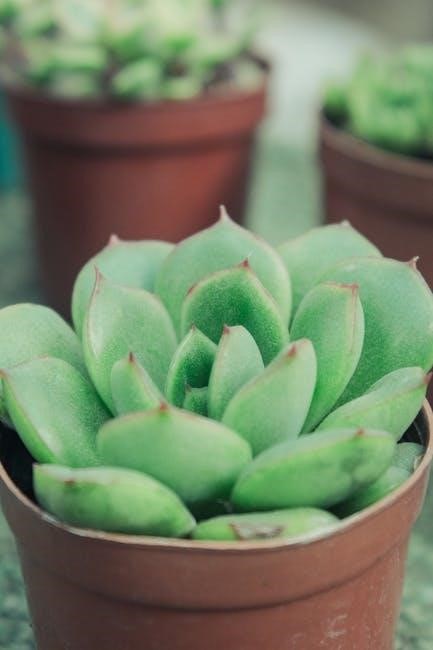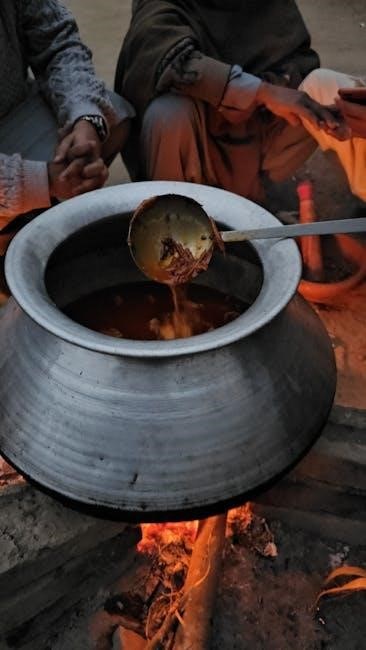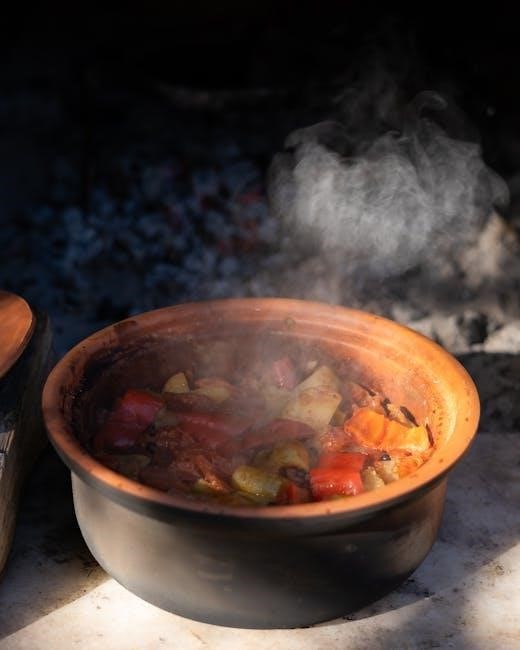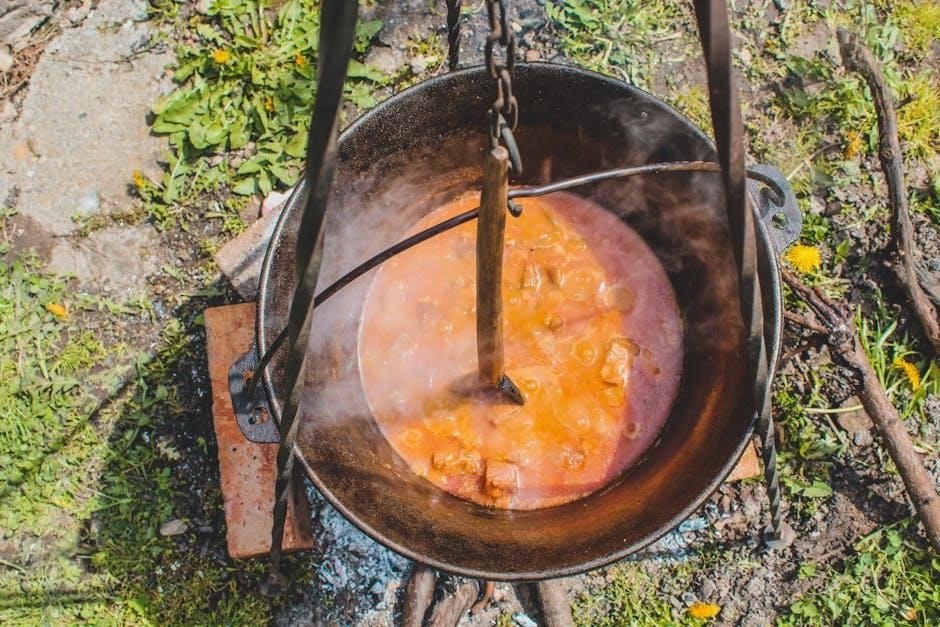Welcome to the ultimate guide for mastering your Crock Pot slow cooker! Discover how to prepare delicious meals effortlessly with step-by-step instructions tailored for beginners and experienced cooks alike.
1.1 Understanding the Basics of Crock Pot Slow Cookers
A Crock Pot slow cooker consists of a stoneware pot‚ heating base‚ and lid. It cooks food at low temperatures over long periods‚ ideal for tenderizing meats and blending flavors. Simple models have basic settings like low‚ high‚ and warm‚ while programmable versions offer timed cooking. Always use the lid during cooking to retain moisture and heat for optimal results.
1.2 Importance of Following Manufacturer Guidelines
Following the manufacturer’s guidelines ensures safe and effective use of your Crock Pot. Proper unpacking‚ cleaning‚ and initial setup prevent damage and maintain performance. Adhering to cooking times and temperature settings guarantees evenly cooked meals. Ignoring instructions may lead to uneven cooking or safety hazards. Always refer to your specific model’s manual for tailored advice to maximize your slow cooker’s potential and longevity.
Preparing Your Crock Pot for First Use
Unpack and wash all components‚ ensuring the stoneware is securely placed in the heating base. Perform a quick test run to prepare your Crock Pot for first use.
2.1 Unpacking and Cleaning the Slow Cooker
Start by carefully unpacking your Crock Pot and removing all packaging materials. Wash the stoneware‚ lid‚ and any other components with warm soapy water. Rinse thoroughly and dry with a clean towel. Ensure no packaging materials remain inside the slow cooker. This step ensures your appliance is clean and ready for its first use‚ avoiding any residual odors or contaminants.
2.2 Initial Setup and Safety Precautions
Place the Crock Pot on a heat-resistant surface and ensure the area is clear of flammable materials. Use a hot pad or trivet underneath to protect the surface. Before first use‚ some slight smoke or odor may occur‚ which is normal. Keep children away‚ as the exterior can get hot. Avoid overheating by ensuring proper ventilation. Never leave the slow cooker unattended during its first operation.
Essential Steps for Using a Crock Pot
Place the stoneware into the heating base‚ add your ingredients‚ and cover with the lid. Plug in your Crock Pot‚ select the desired setting‚ and set the timer for the recommended cooking time. This ensures a perfect‚ hands-off meal preparation.
3.1 Placing the Stoneware and Adding Ingredients
Start by placing the stoneware cooking pot into the heating base. Add your prepared ingredients to the stoneware‚ ensuring not to exceed the recommended fill level. Cover with the lid to trap heat and flavors. Always cook with the lid securely in place to ensure even cooking and prevent moisture loss. This step is crucial for achieving perfectly cooked meals every time.
3.2 Securing the Lid and Setting the Timer
After placing the stoneware‚ secure the lid tightly using the lid lock. Plug in your Crock Pot and select the desired cooking time based on your recipe. Choose between low or high settings‚ depending on your preference and the recipe’s instructions. Once set‚ the slow cooker will begin cooking automatically‚ ensuring even heat distribution. Proper lid sealing is essential for retaining moisture and achieving tender results.

Crock Pot Models and Their Unique Features
Explore popular Crock Pot models like the CHP200 and CHP550‚ each offering distinct features such as programmable settings‚ lid locks‚ and easy-serve designs for convenient slow cooking.
4.1 Crock-Pot Traditional Slow Cooker (CHP200)
The Crock-Pot Traditional Slow Cooker (CHP200) is a classic‚ manual model with low‚ high‚ and warm settings. It features a ceramic stoneware pot for even heating and easy cleaning. Simply place the stoneware in the heating base‚ add ingredients‚ secure the lid‚ and select your desired setting. Its straightforward design makes it ideal for basic slow cooking needs‚ offering reliability and ease of use for home cooks.
4.2 Crock-Pot Lift & Serve Slow Cooker (CHP550)
The Crock-Pot Lift & Serve Slow Cooker (CHP550) offers a convenient design with a locking lid for spill-free transport. It features a digital display for easy programming of cooking time and temperature. The dishwasher-safe stoneware and glass lid make cleanup simple. This model is perfect for entertaining or family meals‚ combining programmable settings with a sleek‚ portable design for effortless slow cooking and serving.

Safety Tips for Operating a Slow Cooker
Always place the slow cooker on a heat-resistant surface and avoid overloading it. Keep children away and never leave the appliance unattended while in use.
5.1 Placing the Slow Cooker on a Heat-Resistant Surface
Always position your slow cooker on a heat-resistant surface‚ such as a trivet or hot pad‚ to protect your countertop from potential heat damage. Avoid placing it near flammable materials or overhanging fabrics. Ensure the surface is flat and stable to prevent the cooker from tipping over during operation.
5.2 Avoiding Common Mistakes During Initial Use
When using your slow cooker for the first time‚ ensure you read the manual thoroughly. Common mistakes include adding pasta too early‚ which can make it mushy‚ and overfilling the stoneware‚ which may lead to spills. Always secure the lid properly to avoid leaks and ensure even cooking. Never place the slow cooker near flammable materials or overhanging fabrics‚ and avoid using abrasive cleaners on the stoneware.
Programmable vs. Manual Crock Pot Models
Programmable models offer flexibility with timers and preset settings‚ while manual models provide simplicity with basic temperature controls‚ catering to different user preferences and cooking needs effectively.
6.1 Understanding Programmable Slow Cooker Settings
Programmable slow cookers offer advanced features like timers‚ preset settings‚ and customizable cooking durations. These models allow users to set specific cooking times and temperatures‚ ensuring dishes are cooked perfectly. Some units also feature delay start and smart technology‚ enabling precise control. Understanding these settings enhances versatility‚ making it easier to adapt recipes and achieve desired results effortlessly.
6.2 Using Manual Controls for Basic Operations
Manual Crock Pot controls are straightforward‚ offering simple settings like low‚ high‚ and warm. These models are perfect for basic cooking tasks‚ allowing users to set a consistent temperature without advanced features. Ideal for those who prefer simplicity‚ manual controls ensure easy operation for everyday meals‚ making them a great choice for essential slow-cooking needs.

Popular Crock Pot Recipes for Beginners
Start with simple‚ delicious recipes like slow-cooked chicken or mac and cheese. These easy-to-follow dishes are perfect for first-time users‚ ensuring flavorful results with minimal effort.
7.1 Simple Chicken Recipe for Slow Cooking
This easy slow-cooked chicken recipe requires minimal effort and delivers flavorful results. Place boneless chicken breasts‚ diced veggies‚ and your favorite sauce in the crock pot. Season with salt‚ pepper‚ and herbs. Cook on low for 6-8 hours or high for 3-4 hours. Serve hot over rice or with crusty bread for a hearty‚ satisfying meal perfect for any occasion.
7.2 Slow-Cooker Mac and Cheese
Combine macaroni‚ shredded cheese‚ milk‚ and butter in the crock pot. Cook on low for 2-3 hours or high for 1-2 hours. Stir halfway through to ensure creamy consistency. For an extra burst of flavor‚ add cooked bacon or a sprinkle of paprika. Serve hot‚ garnished with crispy breadcrumbs for a comforting‚ cheesy dish perfect for family meals or gatherings.
Cooking Pasta in a Crock Pot
Add pasta during the last 30-60 minutes of cooking to prevent it from becoming overly soft. This method ensures perfectly cooked‚ non-mushy noodles every time. Stir gently to combine.
8.1 Adding Pasta During the Last 30-60 Minutes
Add pasta toward the end of cooking to avoid overcooking. This prevents mushiness and ensures al dente texture. Stir gently to combine‚ cover‚ and cook until pasta is tender. Perfect for dishes like mac and cheese or hearty stews. Proper timing guarantees ideal results without compromising flavor or texture. Always follow recipe guidelines for best outcomes.
8.2 Achieving Perfect Texture for Pasta Dishes
Achieve ideal pasta texture by adding it during the last 30-60 minutes of cooking. This prevents overcooking and maintains a firm bite. Use high-quality pasta and ensure it’s fully submerged in liquid. Stir gently to prevent sticking. For cream-based sauces‚ mix well to coat pasta evenly. Always follow recipe guidelines to ensure perfectly cooked‚ flavorful pasta dishes every time. Proper technique guarantees success.

Maintenance and Cleaning Tips
Regularly clean the stoneware and lid with warm‚ soapy water. Avoid abrasive cleaners to prevent scratching. Dry thoroughly after washing and store in a cool‚ dry place.
9.1 Regular Cleaning of the Stoneware and Lid
After each use‚ wash the stoneware and lid with warm‚ soapy water. Avoid using abrasive cleaners or scrubbers to prevent scratching. For tough stains‚ soak the stoneware in warm water before cleaning. Dry thoroughly to prevent water spots. Regular cleaning ensures optimal performance and maintains hygiene. Never submerge electrical components in water. Always follow the manufacturer’s cleaning guidelines for best results.
9.2 Storing the Slow Cooker Properly
Allow the slow cooker to cool completely before storing. Keep the stoneware‚ lid‚ and heating base separate to prevent moisture buildup. Store the cord neatly to avoid tangling. Place the components in a dry‚ secure location‚ away from direct sunlight. Avoid stacking heavy items on the slow cooker to maintain its shape and functionality. Proper storage ensures longevity and safety for future use.
Troubleshooting Common Issues
Identify and resolve common issues like lid locking problems or uneven cooking. Refer to the user manual for solutions to ensure optimal performance and safe operation.
10.1 Resolving Lid Locking Problems
Resolving lid locking issues on your Crock Pot is straightforward. Ensure the lid is properly aligned with the stoneware. Clean the lid and stoneware regularly to remove any food residue that might interfere with the lock. If the lid is difficult to secure‚ apply a small amount of oil to the hinges. For persistent problems‚ consult your user manual or contact customer support for assistance. Proper lid sealing is crucial for even cooking and safety.
10.2 Addressing Uneven Cooking or Temperature Issues
Uneven cooking or temperature issues can often be resolved by ensuring the lid is properly sealed and aligned. Check for worn-out seals or misalignment‚ as this can affect heat distribution. Verify that the slow cooker is placed on a level surface and the power supply is stable. Avoid overfilling the stoneware‚ as this can disrupt airflow. If issues persist‚ consult your user manual for model-specific troubleshooting steps or contact customer support for further assistance.
